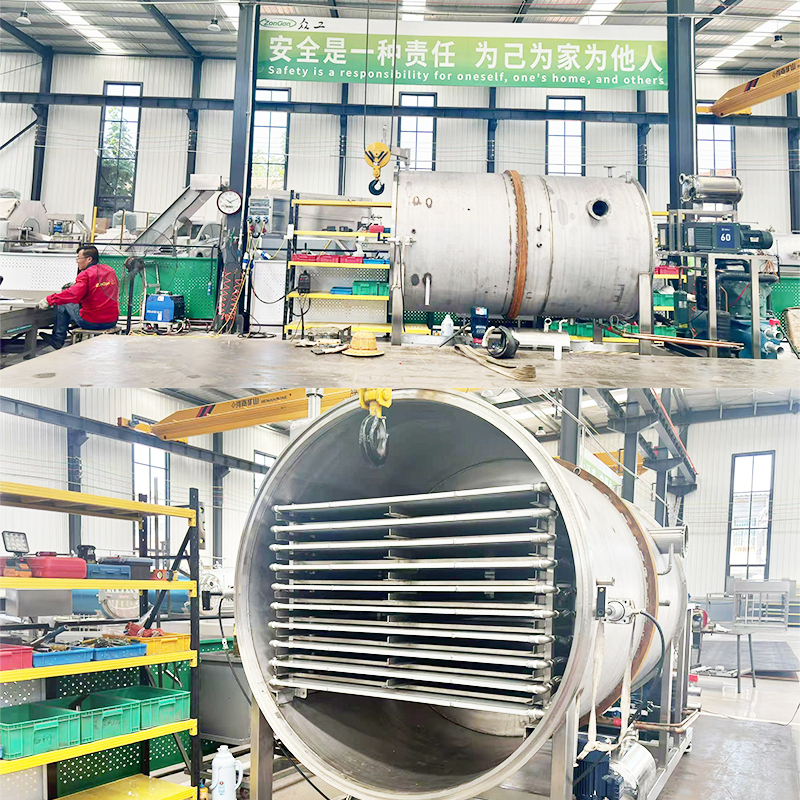

categories
Equipment manufacturing companies need to continuously enrich their products.Currently,we produce new products---- Vacuum freeze dryer,it is renowned for its ability to preserve the physical structure, biological activity, and chemical composition of the sensitive materials it processes.This is Jane,welcome to contact me:Tel/whatsapp/wechat:+8615689806788
The core principle of freeze-drying is sublimation—the direct transition of water from a solid state (ice) to a vapor state without passing through the liquid phase. This is achieved by placing the material under a high vacuum after freezing it. The process consists of three primary stages:
Freezing: The product is first cooled to extremely low temperatures (typically between -40°C and -80°C). This solidifies all the water within the material into ice. The speed of freezing can be controlled to create specific ice crystal structures, which is critical for preserving the product's physical form.
Primary Drying (Sublimation): Under a high vacuum, the pressure is lowered, and just enough heat is carefully applied to the frozen product to provide the energy required for sublimation. The ice crystals sublime directly into water vapor, which is removed from the chamber. This stage removes the vast majority (up to 95%) of the water content. The product's structure remains intact as the solid ice supporting it simply vanishes.
Secondary Drying (Desorption): After the ice is gone, a small amount of water molecules remain, bound to the product's matrix. In this stage, the temperature is raised higher than in primary drying (often to 20-50°C), while the vacuum is maintained. This provides the energy to break these bonds and desorb the remaining water, bringing the residual moisture content down to a very low level (often 1-4%). This is crucial for ensuring long-term stability.
Key Advantages of this Technology:
Minimal Damage: Prevents damage caused by liquid water or high temperatures, preserving the product's structure, shape, and porosity.
Superior Quality: Retains flavor, aroma, nutritional value, and color far better than other drying methods.
Rehydration: Freeze-dried products can be rehydrated quickly and completely, returning very close to their original state.
Stability at Room Temperature: The end product is stable and can be stored without refrigeration for many years.

A freeze-dryer, or lyophilizer, is a complex system designed to execute the three stages above in a controlled and reproducible manner. The main components of a typical lyophilizer are:
Drying Chamber: The vacuum-tight enclosure where the product is placed. It contains:
Shelves: Temperature-controlled plates that hold the product. They can be cooled (for freezing) and heated (for drying) with a circulating fluid (silicone oil). For pharmaceutical use, they are often designed with a stoppering system to seal vials inside the chamber under partial vacuum or inert gas.
Condenser (Cold Trap): A critical component connected to the drying chamber. It is a refrigerator system that cools coils to very low temperatures (e.g., -80°C or even lower). The water vapor that sublimes from the product travels to the condenser and re-freezes (as ice) on these cold coils. This protects the vacuum pump and efficiently removes moisture from the system.
Vacuum System: A pump (or series of pumps) that reduces the pressure in the chamber and condenser to the levels required for efficient sublimation. It works to remove non-condensable gases.
Refrigeration System: Provides cooling for both the shelves (for the freezing phase) and the condenser.
Control System: A sophisticated computer and software interface that allows operators to program, monitor, control, and document the entire process. It precisely regulates shelf temperatures, vacuum pressure, and process time according to pre-set recipes, ensuring consistency and quality.
Types of Lyophilizers:
Laboratory-Scale: Small units used for research, development, and small-batch production. They often feature a manifold for flasks or a small chamber with shelves.
Pilot-Scale: Intermediate-sized units used to scale up processes from the laboratory to full production.
Industrial-Scale: Large, automated systems for continuous commercial production. These are common in pharmaceutical and food manufacturing and may include advanced features like CIP (Clean-In-Place) and SIP (Steam-In-Place) for automated cleaning and sterilization, which are mandatory in GMP (Good Manufacturing Practice) environments.
Pharmaceuticals & Biotechnology: The largest application. Used to preserve vaccines, antibiotics, protein-based drugs, enzymes, diagnostics, and live viral or bacterial preparations (e.g., probiotics).
Food Industry: To produce high-quality, lightweight, shelf-stable foods like instant coffee, fruits for cereals, backpacking meals, and herbs.
Biotechnology & Research: Long-term preservation of tissues, bacteria, viruses, and other sensitive biological samples.
Other Industries: Restoration of water-damaged documents and artifacts, and technical applications in the chemical and nanotechnology sectors.
In summary, vacuum freeze-drying is a unique and powerful preservation technology. While the equipment represents a significant investment and the process is energy-intensive, its unparalleled ability to preserve the integrity of the most sensitive products makes it indispensable in modern industry and science.

Email: zongon@zongon.com
ADD: Xinxing Town Station, Weifang, Shandong, China
 English
English 中文简体
中文简体